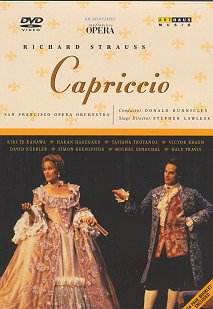Words or Music. Which comes first? which is most
important? These tantalising questions - and the Countess’s choice
between her two admirers, composer, Flamand and librettist, Olivier
- lie at the heart of Richard Strauss’s last opera, or to be precise
as Strauss, himself, described it – "a conversation piece
for music in one act". In this work, the words really do
matter. They are essential to a full appreciation and enjoyment
of the work’s wit and ironies. Attention must be paid to the libretto
(thank goodness for modern video subtitles!). This work beautifully
lampoons operatic excesses (especially those associated with florid
Italian operas, and pompous productions based on classical antiquity),
the inability of modern composers to write works of genius that
will "address people’s hearts" (remember this work was
written in 1940-41 when modernism held sway), the extravagances
of librettists and overblown staging of operas, with side-swipes
at the ballet too. And who better to write the scintillating libretto
for this entertainment than Richard Strauss himself and the conductor
Clemens Krauss both of whom had so much experience of operatic
staging and behind-the-scenes rivalries and tribulations.
Richard Strauss’s music subtly underlines but
never intrudes upon the text with much of it almost recitative-like
although Flamand’s aria declaring his love is lyrical enough.
Then there is the effective number in fugal counterpoint when
La Roche and Flamand are joined by the others debating the importance
of music to the other arts. This is not to forget the equally
clever, quarrelsome octet ‘Sie lichen ihn aus’. Perhaps the most
striking music, for the ear, is left to the end in which we hear
the lovely moonlight music that precedes Countess Madeleine’s
final aria.
Kiri Te Kanawa has made the role of the Countess
something of her own and she certainly looks quite stunning in
the role. The production is in the traditional 18th
century costumes with one big salon set. Te Kanawa’s acting is
fine and her technique is well nigh flawless especially in her
lovely big aria at the end where she looks into herself in a (fruitless)
effort to decide between her suitors. As she looks in the mirror
one senses a striking resemblance to the Marschallin of Der
Rosenkavalier. But Te Kanawa’s singing lacks a degree of
emotional involvement. Kuebler and Keenlyside (especially) are
most convincing as her beaux. Victor Braun’s La Roche is brilliant,
particularly in his wonderful monologue in which he cuts the two
young men down to size declaring their aestheticism pale and insisting
upon the importance of the taste and responsibilities of the theatre
director. Through La Roche, Strauss articulates many ideas that
were close to his heart including complaints about noisy orchestras
drowning out the singers but equally abhorring music that just
presents a pleasant accompaniment. Håkan Hagegård
is a nonchalant Count, a philosopher bent on seduction of Clairon
(Tatiana Troyanos) who is a splendidly haughty but knowing diva.
A witty, intellectually satisfying production
of Richard Strauss's "conversation piece" with winsome performances
especially Victor Braun's La Roche. Kiri enchants but a little
more expressive singing would not have gone amiss.
Ian Lace
